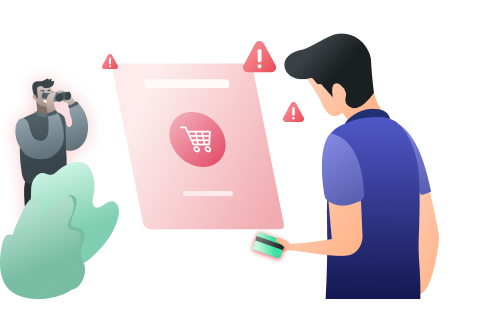The average person spends a significant portion of their day using the Internet, whether they know it or not. From credit card readers at the grocery store to smart appliances in homes across the country, the Internet has never been so integral to our lives. Unfortunately, hackers frequently take advantage of this dependence on the Internet and use it to steal personal data.
Recent reports show that security breaches for personal data have risen by 11% since 2018 and 67% since 2014. Identity theft and data corruption are among the many consequences of having your personally identifiable information (PII) stolen by hackers. One of the best ways to defend yourself against a security breach is to learn how you can identify different ways that hackers steal your data.
Spam
When most people think of hackers or stolen data, the first thing that comes to mind is spam. The practice of sending spam has existed since 1994. This method of obtaining information and infecting unsuspecting users comes in the form of malicious links that are most often sent over email. These spam links typically direct to a site that the hacker created to infect their system or release a virus. After a system has been infected, viruses will begin to steal a user’s data.
Although many of us ignore spam emails when we receive them, a staggering number of users are infected with malware from spam each year. Studies have proven that 94% of malware is delivered by email, which means that it has never been more necessary than to encrypt and protect your private information.
Bots, Viruses, and Worms
Cybercriminals will often employ the help of bots, viruses, and worms to gather sensitive data from their victims. Each tactic provides unique abilities to hackers who are hunting for private information such as login credentials, personal files, and more.
When a hacker uses bots to steal data, they release a number of them to search different websites for any potential vulnerabilities. These vulnerabilities can be related to insufficient encryption or poor security hygiene. Once a bot has located a vulnerability, the hacker can then exploit it to gain access or information from that website.
Using viruses as a means to obtain private user data is another common tactic among hackers. Unlike bots, viruses are self-replicating programs with one purpose: to destroy or steal data. A bot will explore different websites until it finds a weakness, but a virus is released to users whether their security is compromised or not. These viruses can lead to detrimental security breaches, many of which last 280 days from identification to containment.
One of the “drawbacks” of a virus is that it must be attached to a host file. This means that a virus cannot attack a system unless it is downloaded by the victim. With worms, a host file is not necessary. Although they are still considered viruses, worms have a reputation for being even more destructive. Worms can cause DDoS (distributed denial of service) attacks that stop users from being able to access their system entirely. Not only do these worms search a system to steal data and other private resources, but many of them are built to send the information they gather back to hackers and other cybercriminals.

Phishing Scams
The more that the general population relies on phones, the easier it is for hackers to trick people into falling for their traps. Typically, this comes in the form of phishing scams. There are various ways that hackers use phishing to steal data, including SMS-phishing and phone scams.
When a hacker uses SMS-phishing, they are sending text messages to potential victims and posing as trusted organizations or businesses. This can include stores, companies, or even banks. They format the text messages to resemble a legitimate message that someone might receive from that organization to trick users into supplying them with data. Hackers use SMS texts to obtain personal information by encouraging users to visit the link used in their message, which downloads viruses or malware onto their device.
Traditional forms of phishing behave the same way, but the delivery system may be different. Instead of using text messages to trick their victims, hackers will use other phishing methods such as phone calls to verify personal information. This information is then used to obtain login credentials, banking information, social security numbers, and other important data.
Fraudulent Websites
If you have ever attempted to visit a website and received a notification from your security software that said the site was blocked, it was likely that the website was fraudulent. Another frequent tactic employed by cybercriminals is to direct potential victims to websites that exist only to gather private data.
According to recent statistics, 1 in 13 web requests leads to malware. One of the more popular types of fraudulent websites is a fake storefront. Sites that sell clothing or other goods have become a common platform used by hackers. Shoppers will fill their carts with items, only to have their credit card information stolen when they try to make a purchase.
Hackers will also prey on job seekers by creating fake job listings that lead to websites where a user willingly fills in their personal information. This personal data can easily be exploited and used as a way to steal someone’s identity. Cybercriminals often focus their attacks on people looking for something specific, such as a career or new clothing, and leverage that desire for their benefit.

Exploiting Weak Security
Hackers have devised specific tactics to locate weaknesses on different platforms. Depending on the information they’re after, cybercriminals can search for the structural faults in a website’s security in a variety of ways.
One common method of locating this information is through support forums. Hackers will read the different support topics and identify any issues that users have reported about a website or a piece of software. For example, if a cybercriminal were attempting to hack into Google Drive, they would first start by going to a Google Drive support forum to identify any vulnerabilities. Once they identify these weaknesses, they can begin to exploit them for their own means.
Similarly, the act of “spearfuzzing” is another tactic by which hackers detect poor security hygiene. When engaging in spearfuzzing, cybercriminals will visit a website that they hope to infiltrate and begin testing different areas of the site to see if any vulnerabilities may allow them to access the page through a back entrance.
Poor security measures and weak safety protocols are among the most reported causes of hacking by cybercriminals. The best way to protect yourself, and your private information, is to secure your network connection and ensure that no hackers can access your personal data.
Reliable Defense from Potential Security Threats
Hackers are constantly developing new ways to scam victims and steal their data. When you need total protection from security breaches and privacy attacks, you need a VPN that can help you manage your Internet safety needs on any device. PrivadoVPN provides users with a strong and reliable service that allows them to browse the Internet, play video games, and shop online with confidence in the security of their private data.
Download PrivadoVPN
Protect your privacy with a world-class VPN. Sign up for premium access to PrivadoVPN and get unlimited monthly data, access to 300+ servers from around the world, and up to 10 simultaneous connections. Get a top-rated VPN that can secure your privacy at home, at work, or on the go. Sign up for PrivadoVPN today!




